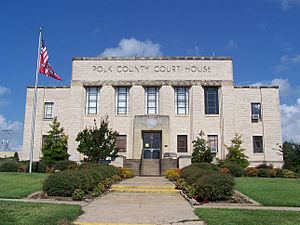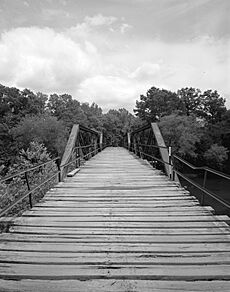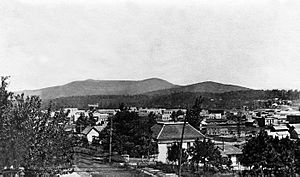Mena, Arkansas facts for kids
Quick facts for kids
Mena, Arkansas
|
|
|---|---|

Polk County Courthouse in Mena
|
|
| Motto(s):
"Where good things happen!"
|
|

Location of Mena in Polk County, Arkansas
|
|
| Country | United States |
| State | Arkansas |
| County | Polk |
| Area | |
| • Total | 6.93 sq mi (17.96 km2) |
| • Land | 6.89 sq mi (17.84 km2) |
| • Water | 0.04 sq mi (0.11 km2) |
| Elevation | 1,171 ft (357 m) |
| Population
(2020)
|
|
| • Total | 5,589 |
| • Density | 811.29/sq mi (313.26/km2) |
| Time zone | UTC−06:00 (Central (CST)) |
| • Summer (DST) | UTC−05:00 (CDT) |
| ZIP Code |
71953
|
| Area code(s) | 479 |
| FIPS code | 05-45170 |
| Website | City of Mena Arkansas |
Mena (/ˈmiːnə/ MEE-nə) is a city in Polk County, Arkansas, United States. It is also the county seat of Polk County. The population was 5,558 as of the 2020 census. Mena is included in the Ark-La-Tex socio-economic region. Surrounded by the Ouachita National Forest, Mena is a gateway to some of the most visited tourist attractions in Arkansas.
Contents
History

Mena was founded by Arthur Edward Stilwell during the building of the Kansas City, Pittsburg and Gulf Railroad (now the Kansas City Southern), which stretched from Kansas City, Missouri to Port Arthur, Texas. Train service to Mena began in 1896.
Stilwell named the town in honor of Folmina Margaretha Janssen-De Goeijen, the wife of his friend and financier Jan De Goeijen, whom Mr. De Goeijen affectionately called Mena. Janssen Park in the center of Mena is also named for her.
Mena was settled in 1896 and incorporated on September 18 of that year. In 1897, the Bank of Mena was founded. The following year, the county seat was moved from nearby Dallas to Mena. Mena's population had grown to 3,423 by 1900. The main industries of the area were timber, agriculture and mineral extraction, though it was advertised as a spa city located within a healthy environment. Stilwell donated land to the city in 1906, and a park and campground were constructed. In 1910, the railroad moved its shop facilities from Mena to Heavener, Oklahoma. This created a loss of eight hundred jobs. A private school in Mena, Hendrix Academy, closed in 1905.
There were attempts to intimidate early Black settlers into leaving between 1896 and 1898. In 1901, an African-American man accused of kicking a White girl, was removed from the jail, beaten, and hanged. Local citizens posted a reward for the murderers; there were no arrests. In the mid-1920s, the town advertised that it had no Negroes. In the early 1900s, the Black population declined, and Mena became known as a Sundown town. In 1920, the Mena Star advertised the city as 100 percent White. In 1937, there were no Blacks in Mena.
In 1911, a damaging tornado struck the town.
Recent history
In the 1950s, a government program to stockpile manganese led to the reopening of local mines closed since the 1890s. The program ended in 1959, and the mines again closed.
On April 9, 2009, a large and violent tornado devastated the town, killing three and injuring thirty. Many homes and businesses were damaged or destroyed. The Arkansas National Guard was deployed to the affected area. The tornado was rated as a high-end EF3, with winds near 165 mph (266 km/h), and damages estimated at $25 million.
Some of the businesses in the community are working to create a Downtown Arts District in Mena, anchored by the Mena Art Gallery at 607 Mena Street. The gallery is a non-profit organization which exhibits about 12 shows a year ranging from invitational to open shows featuring primarily local artists in a variety of media. There is also an annual Children's Exhibit and a High School Exhibit.
Geography
According to the United States Census Bureau, the city has a total area of 6.8 square miles (18 km2), of which 6.7 square miles (17 km2) is land; 0.04 square miles (0.10 km2) (0.44%) is water.
Climate
Mena's climate is characterized by hot, humid summers and generally mild to cool winters, with precipitation occurring in all seasons. The Köppen Climate Classification subtype for this climate is "Cfa" (Humid Subtropical Climate).
| Climate data for Mena, Arkansas (1991–2020 normals, extremes 1891–present) | |||||||||||||
|---|---|---|---|---|---|---|---|---|---|---|---|---|---|
| Month | Jan | Feb | Mar | Apr | May | Jun | Jul | Aug | Sep | Oct | Nov | Dec | Year |
| Record high °F (°C) | 82 (28) |
84 (29) |
90 (32) |
92 (33) |
99 (37) |
105 (41) |
110 (43) |
112 (44) |
107 (42) |
100 (38) |
85 (29) |
80 (27) |
112 (44) |
| Mean daily maximum °F (°C) | 49.4 (9.7) |
54.0 (12.2) |
61.9 (16.6) |
70.4 (21.3) |
77.3 (25.2) |
85.0 (29.4) |
89.7 (32.1) |
89.7 (32.1) |
83.2 (28.4) |
72.6 (22.6) |
60.8 (16.0) |
51.7 (10.9) |
70.5 (21.4) |
| Daily mean °F (°C) | 38.6 (3.7) |
42.4 (5.8) |
50.0 (10.0) |
58.3 (14.6) |
66.7 (19.3) |
74.8 (23.8) |
78.7 (25.9) |
78.0 (25.6) |
71.3 (21.8) |
60.4 (15.8) |
49.3 (9.6) |
41.1 (5.1) |
59.1 (15.1) |
| Mean daily minimum °F (°C) | 27.7 (−2.4) |
30.9 (−0.6) |
38.2 (3.4) |
46.2 (7.9) |
56.1 (13.4) |
64.5 (18.1) |
67.8 (19.9) |
66.3 (19.1) |
59.3 (15.2) |
48.1 (8.9) |
37.9 (3.3) |
30.4 (−0.9) |
47.8 (8.8) |
| Record low °F (°C) | −10 (−23) |
−15 (−26) |
6 (−14) |
21 (−6) |
31 (−1) |
44 (7) |
48 (9) |
47 (8) |
34 (1) |
20 (−7) |
13 (−11) |
−7 (−22) |
−15 (−26) |
| Average precipitation inches (mm) | 3.99 (101) |
4.08 (104) |
5.51 (140) |
6.20 (157) |
7.22 (183) |
4.48 (114) |
4.96 (126) |
4.05 (103) |
4.71 (120) |
5.29 (134) |
5.58 (142) |
5.36 (136) |
61.43 (1,560) |
| Average snowfall inches (cm) | 0.8 (2.0) |
1.8 (4.6) |
0.8 (2.0) |
0.0 (0.0) |
0.0 (0.0) |
0.0 (0.0) |
0.0 (0.0) |
0.0 (0.0) |
0.0 (0.0) |
0.0 (0.0) |
0.0 (0.0) |
0.6 (1.5) |
4.0 (10) |
| Average precipitation days (≥ 0.01 in) | 10.2 | 10.1 | 11.0 | 10.1 | 11.3 | 9.8 | 9.8 | 8.4 | 8.2 | 8.8 | 9.5 | 10.1 | 117.3 |
| Average snowy days (≥ 0.1 in) | 0.6 | 0.7 | 0.3 | 0.0 | 0.0 | 0.0 | 0.0 | 0.0 | 0.0 | 0.0 | 0.0 | 0.5 | 2.1 |
| Source: NOAA | |||||||||||||
Demographics
| Historical population | |||
|---|---|---|---|
| Census | Pop. | %± | |
| 1900 | 3,423 | — | |
| 1910 | 3,953 | 15.5% | |
| 1920 | 3,441 | −13.0% | |
| 1930 | 3,118 | −9.4% | |
| 1940 | 3,510 | 12.6% | |
| 1950 | 4,445 | 26.6% | |
| 1960 | 4,388 | −1.3% | |
| 1970 | 4,530 | 3.2% | |
| 1980 | 5,154 | 13.8% | |
| 1990 | 5,475 | 6.2% | |
| 2000 | 5,637 | 3.0% | |
| 2010 | 5,737 | 1.8% | |
| 2020 | 5,589 | −2.6% | |
| U.S. Decennial Census | |||
2020 census
| Race | Number | Percentage |
|---|---|---|
| White (non-Hispanic) | 4,692 | 83.95% |
| Black or African American (non-Hispanic) | 14 | 0.25% |
| Native American | 95 | 1.7% |
| Asian | 62 | 1.11% |
| Pacific Islander | 4 | 0.07% |
| Other/Mixed | 423 | 7.57% |
| Hispanic or Latino | 299 | 5.35% |
As of the 2020 United States census, there were 5,589 people, 2,341 households, and 1,420 families residing in the city.
Media
The local newspaper is the weekly The Mena Star. The Southwest Times Record, based in Fort Smith, is also sold in Mena and covers both the news of the state and the Arkansas River Valley. A statewide daily, the Arkansas Democrat-Gazette, based in Little Rock, is distributed there too.
The big four television stations in Mena are KFSM (CBS), KHBS (ABC), KNWA (NBC) and KFTA (Fox). KARK (NBC, Little Rock) is also available on cable, dating from the times when KNWA's signal did not reach Mena. KNWA is available over-the-air via a digital sub-channel and on satellite.
KXI97 (sometimes referred to as "Mena All Hazards") is a NOAA Weather Radio station that serves Mena.
Mena now has a tabloid circular, The Polk County Pulse, owned by KENA Radio. This is distributed free of charge in Mena, coming out each Wednesday.
A monthly historical journal is also published in Mena, Looking Glass Ouachita Magazine. The monthly is distributed digitally as well as via special editions at local gift shops and restaurants.
Education
Elementary and secondary education
Public education for elementary and secondary school students is available from two school districts:
- Mena School District, which includes Mena High School
- Ouachita River School District, which includes Acorn High School in Acorn; it was recognized as a 2012 U.S. Department of Education Green Ribbon School.
- Previously that section of Mena was in the Acorn School District. The Ouachita River School District was established by the merger of the Acorn School District and the Oden School District on July 1, 2004.
Post-secondary education
- Commonwealth College was once located at the base of Rich Mountain and was known for its ties to socialism, as well as for being the one-time college of Orval Faubus, former governor of Arkansas.
- Rich Mountain Community College is located in Mena. In 2015, RMCC was accepted into the University of Arkansas network. The two-year post-secondary institution is now known as UA Rich Mountain.
Infrastructure
Transportation
The city is served by Mena Intermountain Municipal Airport. Intercity bus service is provided by Jefferson Lines. Mena is served by US 71 and US 59. They are both concurrent throughout Mena. Interstate 49 is planned to bypass Mena on the eastside.
Utilities
- Rich Mountain Electric Cooperative is a non-profit rural electric utility cooperative headquartered in Mena.
- Within the city limits, electricity is provided by the Southwestern Electric Power Company (SWEPCO).
Notable people
- Nate Bell, former member of Arkansas House of Representatives
- Edwin L. Cox, businessman and philanthropist
- Norris "Tuffy" Goff, comedian and radio actor, played Abner Peabody in the Lum and Abner radio and television programs (born in Cove, Arkansas, raised in Mena)
- Chester Lauck, half of the Lum and Abner comedy pair; played Columbus "Lum" Edwards
- Herbert A. Littleton, Medal of Honor recipient for his actions during the Korean War
- Dennis L. Montgomery, software designer who sold millions of dollars of useless software to the US government
- Marcus Richmond, Republican member of the Arkansas House of Representatives for District 21 in multi-county region; born in Mena in 1956
- Dorothy Shaver, first female president of a major Fifth Avenue store
- Mike Simpson, NFL player
- Olin E. Teague, longtime Texas's 6th congressional district representative; born in Oklahoma, but reared in Mena
- T. Texas Tyler, country singer ("The Deck of Cards")
See also
 In Spanish: Mena (Arkansas) para niños
In Spanish: Mena (Arkansas) para niños




